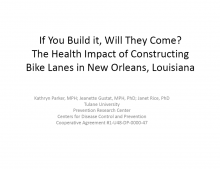We are pleased to announce an exciting new alliance between Active Living Research and GP RED to co-host and coordinate...
If You Build It, Will They Come? The Health Impact of Constructing Bike Lanes in New Orleans, Louisiana

Presentation at the 2010 Active Living Research Annual Conference
Background:
People are more physically active in neighborhoods that are well designed for biking and walking. Bicycle lanes have the potential to draw more people to be physically active and improve the safety of cyclists using the lanes. Devastation caused by Hurricane Katrina in 2005 has created a unique opportunity to rebuild New Orleans as a more bike and pedestrian friendly city. The Louisiana Department of Transportation and Development (DOTD) resurfaced three miles of state highway (St Claude Avenue) that connect four neighborhoods within Orleans and St Bernard Parishes. A local planning engineer advocated for including bike lanes in the resurfacing project and created the technical specifications for the state DOTD to use in their planning. The city Department of Public Works and the state DOTD agencies agreed to create the first exclusive use bike lane in New Orleans while resurfacing St. Claude Avenue. The bike lanes constructed extend 3 miles, are 5 feet wide and located between the parking lane and the outside travel lane. The lanes are identified with both signage and pavement markings to alert both motorists and bicyclists to their presence.
Objectives:
Determine whether construction of new bike lanes would increase the number of riders observed and improve the number of riders riding in the correct direction.
Methods:
In November of 2007 and again in November 2008, trained observers conducted manual counts of cyclists riding on St Claude Avenue in New Orleans, LA. The data collected included the number of men, women, adults and children riding a bicycle with traffic, against traffic and on sidewalks. There were 10 baseline observation days and 14 follow-up observation days. Data was gathered hourly for an eight-hour period from 8 am to 5 pm, weekdays and weekends. Cyclists were classified by age group and gender according to standard protocols. A T-test was used to test the differences between means. A p-value <0.05 was considered significant.
Results:
Baseline data showed an average of 77 male riders per day and 12 female riders per day. There were very few children observed riding at both baseline and follow up. Data showed a 57% increase in the average number of bike riders per day (p<0.000). There was a 133% increase among adult female riders and a 44% increase among adult male riders. The percentage of cyclists riding in the correct direction, with the flow of traffic, increased from 73% to 82% (p<0.000). The average number of riders during weekdays was 92 at baseline and 143 at follow up, while the average number of riders during weekend days was 86 at baseline and 140 at follow up.
Conclusions:
Bike lanes can have a positive impact in creating a healthy physical environment. There were more adults, particularly women, observed biking after the lanes were constructed. Future research should include other streets for comparison purposes and surveys to determine whether riders are substituting biking for non-active forms of transportation.
Support:
The Prevention Research Center at Tulane University is a member of the Prevention Research Centers program, supported by the Centers for Disease Control and Prevention under cooperative agreement number 1-U48-DP-000047.
STAY UP TO DATE
RECENTLY ADDED TOOLS & RESOURCES
MOVE! A BLOG ABOUT ACTIVE LIVING
The "Active Living Conference" aims to break down research and practice silos and...







